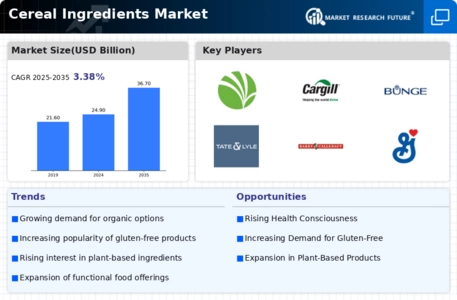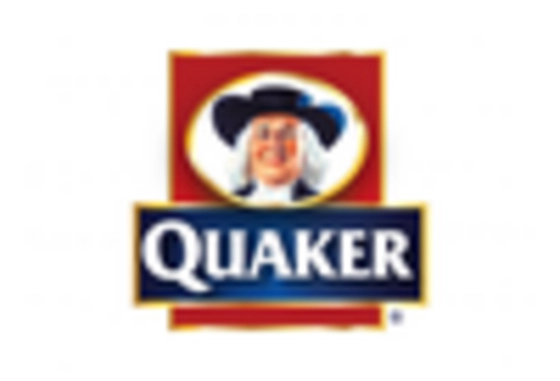Rising Demand for Plant-Based Ingredients
The Cereal Ingredients Market is experiencing a notable shift towards plant-based ingredients, driven by increasing consumer awareness regarding health and sustainability. As more individuals adopt vegetarian and vegan diets, the demand for plant-based cereals and their ingredients is likely to rise. According to recent data, the plant-based food market is projected to reach a value of approximately 74 billion dollars by 2027, indicating a robust growth trajectory. This trend is influencing manufacturers to innovate and diversify their product offerings, incorporating ingredients such as oats, quinoa, and other grains that align with consumer preferences. Consequently, the Cereal Ingredients Market is adapting to these changes, focusing on the development of nutritious and sustainable products that cater to the evolving dietary habits of consumers.
Growing Popularity of Gluten-Free Products
The growing popularity of gluten-free products is significantly influencing the Cereal Ingredients Market. With an increasing number of consumers diagnosed with celiac disease or gluten sensitivity, there is a rising demand for gluten-free cereals and their ingredients. This trend is prompting manufacturers to explore alternative grains such as rice, corn, and millet, which serve as suitable substitutes for traditional wheat-based cereals. Market data suggests that the gluten-free food market is expected to reach a valuation of over 33 billion dollars by 2026, indicating a substantial growth opportunity for the Cereal Ingredients Market. As consumer preferences continue to shift towards gluten-free options, manufacturers are likely to invest in research and development to create innovative products that cater to this segment.
Expansion of E-commerce and Online Retailing
The expansion of e-commerce and online retailing is transforming the Cereal Ingredients Market. As consumers increasingly turn to online platforms for their grocery shopping, manufacturers are adapting their distribution strategies to capitalize on this trend. E-commerce provides a convenient avenue for consumers to access a wide variety of cereal products, including specialty and niche items that may not be available in traditional retail outlets. Recent statistics indicate that online grocery sales are projected to grow significantly, with a substantial portion of consumers preferring to purchase food products online. This shift is encouraging the Cereal Ingredients Market to enhance its online presence and marketing strategies, ensuring that products are readily available to meet the demands of the modern consumer.
Technological Advancements in Food Processing
Technological advancements in food processing are playing a crucial role in shaping the Cereal Ingredients Market. Innovations such as extrusion, freeze-drying, and advanced milling techniques are enhancing the quality and functionality of cereal ingredients. These technologies enable manufacturers to produce cereals with improved textures, flavors, and nutritional profiles, thereby meeting the diverse needs of consumers. Furthermore, the integration of automation and artificial intelligence in production processes is streamlining operations, reducing costs, and increasing efficiency. As a result, the Cereal Ingredients Market is likely to witness a surge in the introduction of novel products that leverage these technological advancements, ultimately catering to the evolving preferences of health-conscious consumers.
Increased Consumer Awareness of Nutritional Value
Consumer awareness regarding the nutritional value of food products is significantly impacting the Cereal Ingredients Market. As individuals become more health-conscious, they are actively seeking cereals that offer enhanced nutritional benefits, such as high fiber content, low sugar levels, and added vitamins and minerals. This shift in consumer behavior is prompting manufacturers to reformulate their products, ensuring that they meet the growing demand for healthier options. Recent studies indicate that cereals fortified with essential nutrients are gaining popularity, with a marked increase in sales of such products. This trend suggests that the Cereal Ingredients Market must prioritize the development of ingredients that not only meet taste preferences but also provide substantial health benefits, thereby appealing to a broader audience.


















Leave a Comment